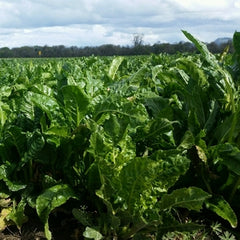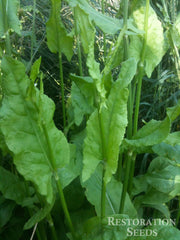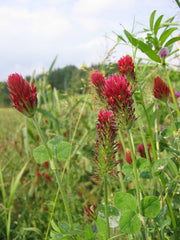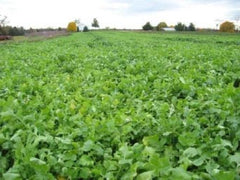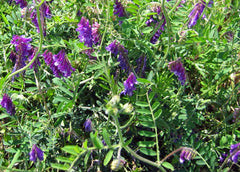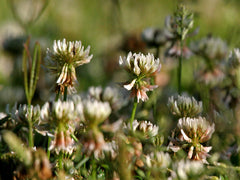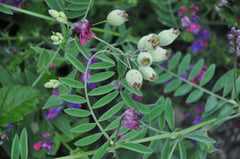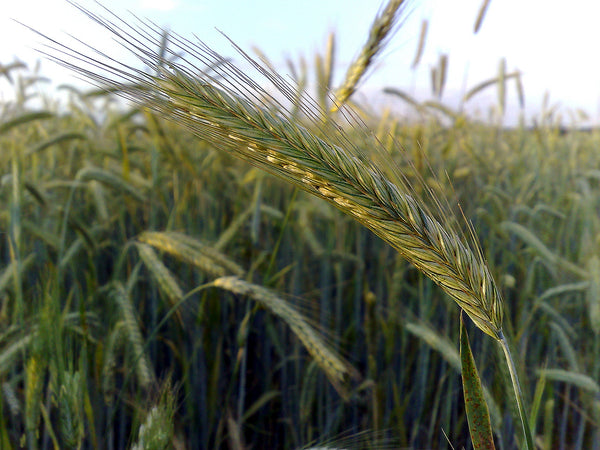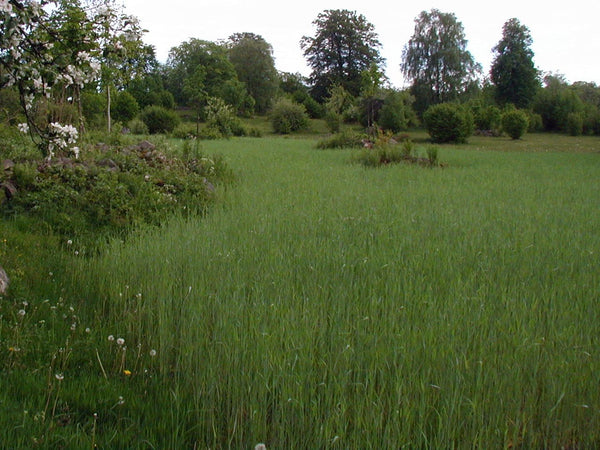Winter rye
Secale cerealeSOWING
Rye can establish in very cool weather. It will germinate at temperatures as low as 34° F. Vegetative growth requires 38° F or warmer. Rye is more sensitive to seeding depth than other cereals, so plant no deeper than 2”.
MANAGEMENT
Winter Annual Seed from late summer to midfall in Hardiness Zones 3–7 and from fall to midwinter in Zones 8 and warmer. In the Upper Midwest and cool New England states, seed two to eight weeks earlier than a wheat or rye grain crop to ensure maximum fall, winter and spring growth. Elsewhere, your tillage system and the amount of fall growth you prefer will help determine planting date.
Mixed Seeding Sow rye at the lowest locally recommended rate when seeding with a legume and at low to medium rates with other grasses. In a Maryland study, a mix of 42 lbs of rye and 19 lbs of hairy vetch per acre was the optimum fall seeding rate before no-till corn on a silt loam soil. If planting with clovers, seed rye at a slightly higher rate, about 56 lbs per acre.
Spring Seeding Although it’s not a common practice, you can spring seed cereals such as rye as a weed-suppressing companion, relay crop or early forage. Because it won’t have a chance to vernalize, the rye can’t set seed and dies on its own within a few months in many areas. This provides good weed control in asparagus, says Rich deWilde, Viroqua, WI.
Management Cautions Although rye’s extensive root system provides quick weed suppression and helps soil structure, don’t expect dramatic soil improvement from a single stand’s growth. Left in a poorly draining field too long, a rye cover could slow soil and warming even further, delaying crop planting. It’s also not a silver bullet for eliminating herbicides. Expect to deal with some late-season weeds in subsequent crops.
KILLING
Nutrient Availability Rye grows and matures rapidly in spring, but its maturity date varies depending on soil moisture and temperature. Tall and stemmy, rye immobilizes nitrogen as it decomposes. The nitrogen tie-up varies directly with the maturity of the rye. Mineralization of nitrogen is very slow, so don’t count on rye’s over wintered nitrogen becoming available quickly. Killing rye early, while it’s still succulent, is one way to minimize nitrogen tie-up and conserve soil moisture. But spring rains can be problematic with rye, especially before an nitrogen-demanding crop, such as corn. Late killing of rye can deplete soil moisture and could produce more residue than your tillage system can handle. For no-till corn in humid climates, however, summer soil-water conservation by cover crop residues often was more important than spring moisture depletion by growing cover crops.
Legumes Combo Offset yield reductions from rye’s immobilization of nitrogen by increasing your nitrogen application. Grow rye with a legume allows you to delay killing the covers by a few weeks and sustain yields. This gives the legume more time to fix nitrogen, in some cases doubling the nitrogen contribution, and rye more time to scavenge a little more leachable nitrogen. The higher residue level can conserve soil moisture. For best results, wait about 10 days after killing the covers before planting a crop. This ensures adequate soil warming, dry enough conditions for planter coulters to cut cleanly and minimizes allelopathic effects from rye residue.
Kill Before it Matures Tilling under rye usually eliminates regrowth, unless the rye is less than 12 inches tall. Rye often is plowed or disked in the Midwest when it’s about 20” tall. Incorporating the rye before it’s 18 in. high could decrease tie-up of soil N. In Pennsylvania and elsewhere, kill at least 10 days before planting corn. For best results when mow-killing rye, wait until it has begun flowering. A long-day plant, rye is encouraged to flower by 14 hours of daylight and a temperature of at least 40° F. A sickle bar mower can give better results than a flail mower, which causes matting that can hinder emergence of subsequent crops. To learn more see the SARE link below.
ADAPTATION
Rye grows well in much poorer soils than those necessary for most cereal grains. Thus, it is an especially valuable crop in regions where the soil has sand or peat. Rye plants withstand cold better than other small grains do. Rye will survive with snow cover that would otherwise result in winter-kill for winter wheat.
TOLERANCE
Rye is more cold and drought-tolerant than wheat. Oats and barley do better than rye in hot weather.
PESTS
Rye is a good choice before a small grain crop such as wheat or barley unless you can kill rye reliably and completely, as volunteer rye seed would lower the value of other grains. While insect infestations are rarely serious with rye, as with any cereal grain crop occasional problems occur. If armyworms have been a problem, for example, killing rye before a corn crop could move the pests into the corn.
Expect very few diseases when growing rye as a cover crop. A rye-based mulch can reduce diseases in some cropping systems. No-till transplanting tomatoes into a mix of rye/vetch/crimson clover, for example, consistently has been shown to delay the onset of early blight in several locations in the Northeast. The mulch presumably reduces soil splashing onto the leaves of the tomato plants.
SHIPPING COST
25-lb., 50-lb. and larger sizes ship via ground transportation. Select the appropriate Bulk Shipping option at checkout. We may email you additional shipping costs separately based on your total order weight, zone and palleting costs.
LEARN MORE
SARE and Managing Cover Crops Profitably, 3rd Edition.
Days from maturity calculated from the date of seeding. Average 10,700–12,000 seeds per pound. Sow average of 60–120 lbs per acre drilled, sow 90–160 lbs per acre broadcast, 4–5 lb per 1000 square feet. Usual seed life: 3–4 years.
Planting Depth 3/4” to 2”
Soil Temp. Germ. 34–68˚F
Days to Germ. 5–8
Plant Spacing 6–9.5”
Row Spacing 6–10”
Days To Maturity 330–345
Full Sun, Moist Well Drained Soil
Winter Seed Count
1 Pound ≈ 11,512 seeds
5 Pounds ≈ 57,562 seeds
25 Pounds ≈ 288m seeds
50 Pounds ≈ 576m seeds
- 1 Pound$5.50
- 5 Pounds$20.00
Rye, ryegrain or cereal rye is a cereal grain and should not be confused with ryegrass, which is used for lawns, pasture and hay for livestock. The hardiest of cereals, rye can be seeded later in fall than other cover crops and still provide considerable dry matter, an extensive soil-holding root system, signific...
Rye, ryegrain or cereal rye is a cereal grain and should not be confused with ryegrass, which is used for lawns, pasture and hay for livestock. The hardiest of cereals, rye can be seeded later in fall than other cover crops and still provide considerable dry matter, an extensive soil-holding root system, significant reduction of nitrate leaching and exceptional weed suppression. Taller and quicker-growing than wheat, rye can serve as a windbreak and trap snow or hold rainfall over winter. It over seeds readily into many high-value and agronomic crops and resumes growth quickly in spring, allowing timely killing by rolling, mowing or herbicides. Pair rye with a winter annual legume such as hairy vetch to offset rye’s tendency to tie up soil nitrogen in spring. Fall-planted rye shows fast growth. By the summer solstice, plants reach their maximum height of about a 4’ (120 cm) while spring-planted wheat has only recently germinated.
A Maryland study credited rye with holding 60 percent of the residual N that could have leached from a silt loam soil following intentionally over-fertilized corn. A Georgia study estimated rye captured from 69 to 100 percent of the residual N after a corn crop. Rye increases the concentration of exchangeable potassium (K) near the soil surface, by bringing it up from lower in the soil profile.
In most regions, rye can serve as an over wintering cover crop after corn or before or after soybeans, fruits or vegetables. Rye also works well as a strip cover crop and windbreak within vegetables or fruit crops and as a quick cover for rotation gaps or if another crop fails. You can over seed rye into vegetables and tasseling or silking corn with consistently good results. You also can over seed rye into brassicas, into soybeans just before leaf drop or between pecan tree rows.
An excellent source of residue in no-till and minimum-tillage systems and as a straw source, rye provides up to 10,000 pounds of dry matter per acre, with 3,000 to 4,000 lbs typical in the Northeast. A rye cover crop might yield too much residue, depending on your tillage system, so be sure your planting regime for subsequent crops can handle this.
Rye is one of the best cool season cover crops for out competing weeds, especially small-seeded, light-sensitive annuals such as lambsquarters, redroot pigweed, velvetleaf, chickweed and foxtail. Rye also suppresses many weeds allelopathically, including dandelions and Canada thistle and has been shown to inhibit germination of some triazine-resistant weeds. Rye reduced total weed density an average of 78% when rye residue covered more than 90 percent of soil in a Maryland no-till study, and by 99% in a California study.
Rye bread, including pumpernickel, is a widely eaten food in Northern and Eastern Europe. Rye is also used to make crisp bread. Rye flour is high in gliadin but low in glutenin. It therefore has a lower gluten content than wheat flour. It also contains a higher proportion of soluble fiber.
Tags: Specialty: Cool Climate, Specialty: Cover Crop, Specialty: Drought Tolerant.Rye is one of a number of species that grow wild in central and eastern Turkey and in adjacent areas. Domesticated rye occurs in small quantities at a number of Neolithic sites in Turkey, such as PPNB Can Hasan III, but is otherwise virtually absent from the archaeological record until the Bronze Age of central Europe, c. 1800–1500 BC. It is possible that rye traveled west from Turkey as a minor admixture in wheat and was only later cultivated in its own right.
